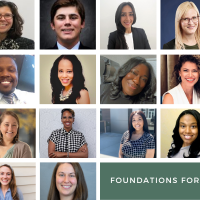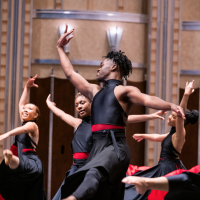18,720. That’s how many pool noodles (yes, pool noodles) it will take to create a one-night, temporary installation for the Cleveland Museum of Art’s Summer Solstice Celebration on June 20th. Yesterday I stopped by the Museum’s new East Wing to see the project take shape.

- Mark Reigelman explains the ideas behind his art

More than 18,000 pool noodles were used in this project

When completed, it will stretch over 500 feet long.
[youtube]”http://www.youtube.com/watch?v=kmKVWU9ZNHE”[/youtube]
This eye-catching work, created and launched by our friends at Cleveland Public Art (CPA), tells more than a story of traditional summer solstice bonfires, it’s a reminder for all of us working in the nonprofit field that there are lessons to be learned from public art—ideas that can shape the way we do our jobs and achieve our respective missions.
My conversations with Cleveland Public Art staff and artist Mark Reigelman left me inspired and caused me to ask:
What can we, as a nonprofit community, learn from public art?
Here’s my take:
Partnerships: Cleveland Public Art is one of our city’s smartest, most creative and nimble organizations. You may know their work—having seen it on Cleveland streets and throughout our neighborhoods—without knowing exactly who they are. Often, CPA partners with large institutions and major government entities to achieve its goals (as they did with CMA for the Summer Solstice Wood-Pile). What can we all learn from CPA about working together? When is it worth it and why? In your opinion, what type of leaders form the best, most effective partnerships?
Creativity and Energy: Wood-Pile artist Mark Reigelman’s work lines our streets (and there’s more to come). From our brief conversation, it was clear that he’s a thoughtful artist who challenges traditional landscapes and is quick to mix humor with quality work. How are artists shaping our community, changing the way we view ourselves and our city? What can creative thinkers (and doers) teach us as about innovation that will improve our approach to nonprofit management?
Flexibility: Now more than ever, nonprofit leaders are being challenged to do more with less. With resources at a premium and new budget/programmatic challenges arising everyday, our healthiest nonprofits are those that know how to adapt. When things don’t work as planned or situations change, how are you as a nonprofit executive reacting and planning for the future? See Mark’s commentary on Day 7: “case of the dwindling glue,” for inspiration.
[youtube]”http://www.youtube.com/watch?v=HzLvY-Sdtj8&feature=related”[/youtube]
Relevancy: Quality public art—true to its name—connects with audiences beyond traditional gallery visitors or high level arts patrons. It engages with the community and plays off its surroundings. How do you know if your organization is connecting with its constituents? Are you willing to reach out to new groups and learn from others? How is your leadership/board changing with the times? Are you relevant?
Consider these questions (or noodle on them, if you wish). Post your responses or links to other helpful resources. And join us June 20th for CMA’s Summer Solstice event and the unveiling of Cleveland Public Art’s Wood-Pile! Join the Party: CMA’s East Wing Opening, Saturday, June 20th, 5 p.m. – 2 a.m.

